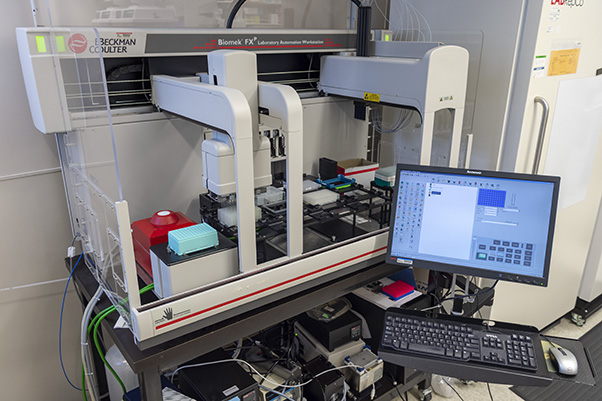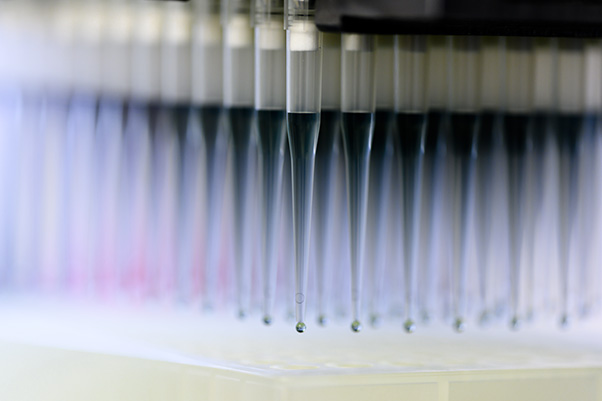Editor’s note: This article is part of a series about scientific devices in use at NCI at Frederick and the Frederick National Laboratory. Other parts of the series can be found here. Mention of trade names, commercial products, or organizations does not imply endorsement by the U.S. government.
Sitting at a computer in an NCI at Frederick laboratory, Todd Hartley writes an automated method for an experiment. With a final swipe of the mouse, he clicks an on-screen button that says “Run.” The large device sitting to his left, a Biomek FXP Laboratory Automation Workstation, whirrs to life. A robotic arm hovers over a deck containing various microplates then lowers a group of pipette tips to draw liquid from a reservoir, raises and moves again, and deposits the fluid in a nearby microplate with superhuman accuracy.
The Biomek FXP is a programmable tool that aspirates and dispenses various liquids used in scientific research. While the multi-hundred-thousand-dollar instrument doesn’t initially seem as flashy as other devices at NCI at Frederick, it has proven its usefulness by helping scientists across the institution conduct research that would normally be tedious and time-consuming.
“You can do things with a liquid handler that you wouldn’t do easily by hand relatively quickly,” said Hartley, a senior instrument engineer and the Biomek’s chief programmer.
The laboratory’s Biomek is a long, open rectangular box with a robotic arm on each end. In the middle is a large lattice-like deck with more than a dozen slots for liquid reservoirs and microplates—small plastic trays that contain anywhere from ten to several hundred tapered wells for holding liquid. Each arm has a group of mandrels for carrying pipette tips—tapered, cylindrical tubes that resemble a turkey baster—with which it aspirates, moves, and dispenses liquid.
Hartley uses an accompanying software package to configure the Biomek for each new experiment or method. Working with an onscreen schematic, he tells the instrument where reservoirs and plates will be located on the deck and creates the step-by-step process by which the arms will interact with the labware—down to the amount of liquid drawn and the time when the arms eject their pipette tips and pick up clean ones.
Hartley can complete a simple method in as little as 20 minutes, but complex projects can require several days or weeks to complete the necessary testing before trusting the Biomek with real samples. Often, it depends on the needs of the team conducting the experiment. The Biomek is available to many scientists at NCI at Frederick, and Hartley says that, as a result, he has written intricate methods for a wide variety of research.
Although the initial configuration is occasionally time-consuming, the completed methods are saved so that scientists can easily access and run their method again in the future.
“They just find the method in there, hit the ‘Run’ button—it will show a layout of the deck and where to put everything on it—tell it to do it, and sit back and watch,” Hartley said.
Some of the most elaborate methods can run for up to 15 hours, but because the Biomek is fully automated, scientists can initiate a method then focus their time on other tasks. Automation also significantly diminishes the chance for human error. As a result, the Biomek is more repeatable and accurate than a human doing the same procedure by hand. Plus, using the Biomek saves lab personnel from performing repetitive hand motions that can lead to carpal tunnel injuries.
The Biomek also combines precision with versatility. Both arms can aspirate and dispense as little as one microliter of liquid—a droplet two million times smaller than a standard two-liter soda bottle and so miniscule that it’s barely visible to the human eye. The left arm can carry 96 pipette tips and is useful for depositing uniform amounts of liquid into microplates. The right carries eight tips that draw liquid independently of each other, which allows scientists to fine-tune the liquid level in individual wells or segregate liquids and transfer particularly important samples to new wells.
“[The Biomek is] very good if you’re going to do large amounts of repetitive pipetting. It saves you and your hand from a lot of tedious hand pipetting,” Hartley said.
Todd Hartley has developed methods and serviced the Biomek for many years and can be contacted at x1775 or hartleyt@mail.nih.gov.




